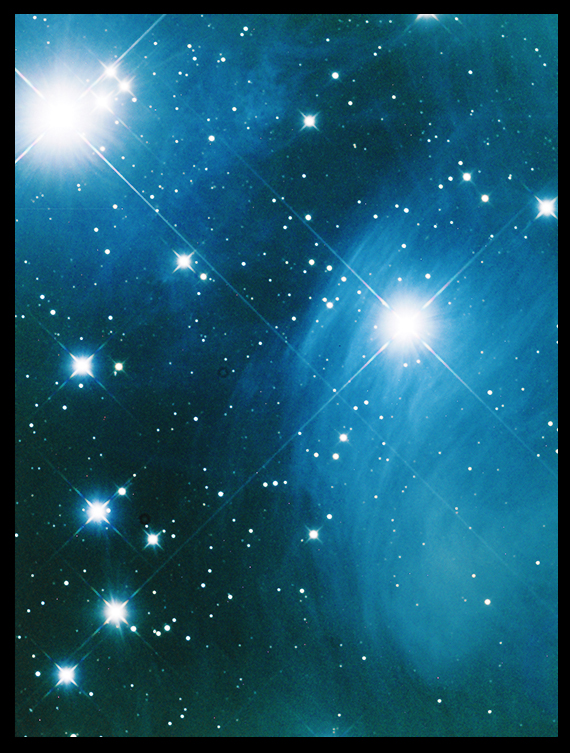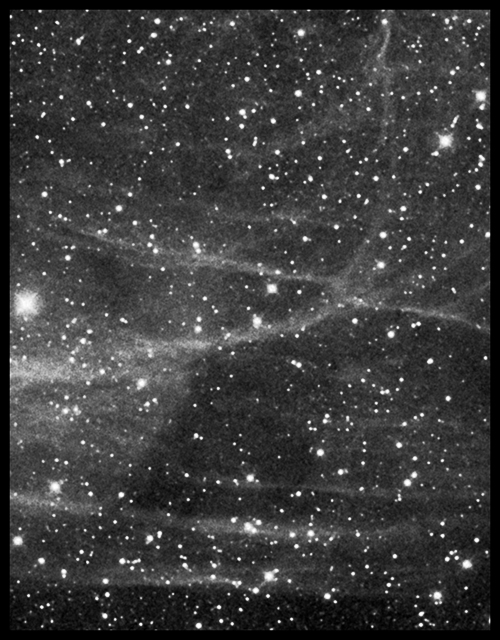2/21/2012. Not much snow, but plenty of clouds this month have kept the telescope covered. A clear night a week ago let me image nebulosity in the Pleiades, and last night I set up to do a sequence of three faint targets. I only got the first one done before clouds returned.

Small area within the Pleiades, Merope at right
16x300s L, 4x300s RGB
AT10RC @ F4.8

Small area within the Pleiades, Merope at right
16x300s L + 4x300s B treated as L
AT10RC @ F4.8
Simeis 147 is a supernova remnant in Taurus near the border of Gemini. It's said to be wicked faint and it
is certainly huge. With an approximate radius of 1.5°, it
covers about seven square degrees, ten times the field of view of the Ritchey in its widest configuration. I picked the southernmost portion of the remnant and exposed for a total of four hours: six 1800s exposures through the 7nm Baader H-a filter, and one LRGB sequence of 900s exposures. I had in mind a color portrait, but in bringing up the bright strands within the nebula, the mix went all red, all the time. So let's do a straight H-a monochrome image, and let's get a couple of nights' data before trying to do much witih it.
2/22/2012: Last night was clearer than I expected. I used the first few hours to gather more light from Simeis 147 -- with not a lot of improvement, actually. This 6h30m exposure is not markedly better than the photos I worked up using only yesterday's 3 hour's of exposure. I'm thinking there's a lot more in the data than I know how to display. Practice, Mister, practice. I'm showing it small to control noise; how's that for sophisticated technique?

Simeis 147
13x1800s Ha
(6h30m)
AT10RC @ F4.8
One benefit of this frame is that I have finally nailed down the orientation of the imaging and guide chips within the ST2000 camera body. Used it for years, never been really sure. Go figure. Here, with the camera inserted in the focuser so that its cables emerge toward the top of the OTA, the frame is vertical and the guide chip leads the imaging chip. Here's a chart from Guide 9.0 showing both chips. The chart is uninverted, E left, N up:

Note that he field offers an excellent, 6th magnitude guide star which allowed 0.4 arcsecond guiding with short, 4s integrations even through the H-a filter.
After trying to improve the Simeis 147 image, I let the telescope work from midnight to four imaging the dwarf galaxy Leo 1 behind brilliant Regulus. Just under one million light-years away and only loosely bound, the brightest stars of Leo 1 are resolved about as easily as those that comprise the middling and fainter population of a big globular cluster. There are very few guide stars on the leading side of this field; I used a 13.6 magntude star and 20s guide integrations. And watch out for the reflection of Regulus; my first composition put that bright blue donut right on top of Leo 1.

Leo 1
27x300s L, 2x300s RGB
AT10RC @ F4.8
Except where noted, deep-sky photos are made with an SBIG ST2000XM CCD behind a 10-inch Astro-Tech Ritchey-Chretien carried on an Astro-Physics Mach1GTO. The CCD is equipped with Baader LRGB and 7nm H-a filters. The internal guide chip of the CCD most often keeps the OTA pointed in the right direction (I'll let you know when a Meade DSI and a separate OAG or guidescope takes its place). Camera control and guiding are handled by Maxim DL 5.12. The stock focuser on the AT10RC has been augmented with Robofocus 3.0.9 using adapters turned on the lathe downstairs. Maxim performs image calibration, alignment, and stacking; Photoshop CS4 and FocusMagic 3.0.2 take it from there. Gradient Xterminator by Russell Croman and Astronomy Tools by Noel Carboni see their share of work, too. Beginning in May 2013, PixInsight has taken over some of the heavy lifting for transfer function modification and deconvolution.
:: top ::